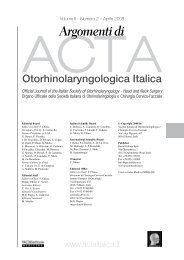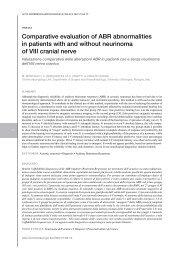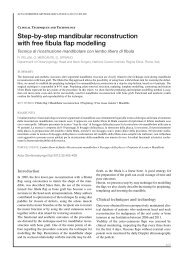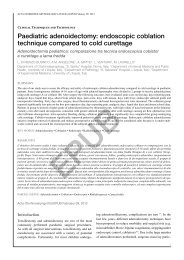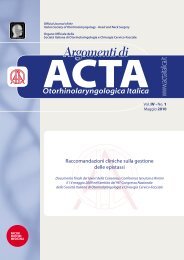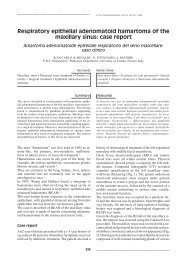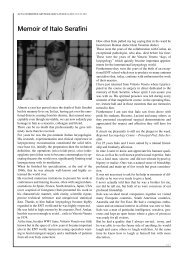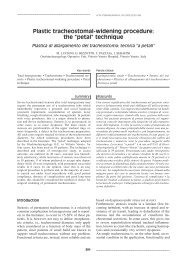Psychological profile and social behaviour of working adults - Acta ...
Psychological profile and social behaviour of working adults - Acta ...
Psychological profile and social behaviour of working adults - Acta ...
You also want an ePaper? Increase the reach of your titles
YUMPU automatically turns print PDFs into web optimized ePapers that Google loves.
<strong>Psychological</strong> <strong>pr<strong>of</strong>ile</strong> <strong>of</strong> <strong>working</strong> <strong>adults</strong> with hearing lossTable I. Socio-demographic characteristics <strong>and</strong> audiometric derived measure <strong>of</strong> hearing thresholds (PTA) <strong>of</strong> the two samples (NH <strong>and</strong> HL)NH (n = 96) HL (n = 73) Statistics Df pSexMale 46 (48.0%) 41 (48.0%) χ 2 = 0.000 1 0.997Female 50 (52.0%) 53 (52.0%)Age (yrs)Mean (SD) 47.1 (8.9) 46.0 (9.1) t = - 1.1 180 0.272Education (yrs)Mean (SD) 12.1 (6.3) 11.2 (5.0) t = 0.427 180 0.670OccupationPr<strong>of</strong>essional 49 (51%) 37 (51%)Non-pr<strong>of</strong>essional 47 (49%) 36 (49%) = 0.002 1 0.543Marital statusMarried or cohabiting 71 (74%) 54 (74%) χ 2 = 0.78 1 0.87Single 25 (26%) 19 (26%)PTA (dB HL)Mean (SD) 15.5 (3.8) 39.6 (7.6) t = - 29 201 < 0.000ter. In the framework <strong>of</strong> this study, we employed the (SF)<strong>and</strong> the (RE) subscales. The first measures the impact <strong>of</strong>physical <strong>and</strong> emotional problems on <strong>social</strong> activities (withfamily, friends, neighbours <strong>and</strong> groups), while the secondrates the interference <strong>of</strong> emotional problems (such as feelingdepressed or anxious) with work <strong>and</strong> other regular dailyactivities.Specifically, <strong>social</strong> <strong>behaviour</strong> was assessed with the SocialFunctioning Questionnaire 38 , an eight-item self-rating scale(score range 0-24) covering the most important domains <strong>of</strong><strong>social</strong> life, such as work, home activities, finance, <strong>social</strong>,family <strong>and</strong> sexual relationships <strong>and</strong> spare time activities.The revised version <strong>of</strong> the Symptom Check List-90 (SCL-90-R), a valid <strong>and</strong> reliable psychiatric multidimensionalself-report inventory 39 , was the tool used to screen forpsychopathological symptom pattern <strong>and</strong> level <strong>of</strong> distressin community <strong>and</strong> medical responders. The 9 primarysymptom dimensions are labelled as follows: 1) somatization(SOM) that reflects distress arising from the perception<strong>of</strong> body dysfunction, 2) Obsessive-Compulsive(O-C) includes <strong>behaviour</strong>s that are closely related to theclinical syndrome <strong>of</strong> the same name, 3) Interpersonal Sensitivity(INT) focuses on feelings <strong>of</strong> personal inadequacy<strong>and</strong> inferiority particularly in comparison with other individuals,4) Depression (Dep) identifies signs <strong>of</strong> loss<strong>of</strong> interest in activities, lack <strong>of</strong> motivation, loss <strong>of</strong> vitalenergy <strong>and</strong> suicidal ideation, 5) Anxiety (Anx) includesgeneral signs such as nervousness, tension <strong>and</strong> restlessness,6) Hostility (Hos) reflects thoughts, feelings <strong>and</strong> actions<strong>of</strong> hostile <strong>behaviour</strong>, such as: annoyance, urges tobreak things <strong>and</strong> uncontrollable temper outbursts, 7) PhobicAnxiety (Phob) ranges fears <strong>of</strong> a phobic nature relatedto travelling, open spaces, crowds or public places <strong>and</strong>conveyances, 8) Paranoid Ideation (PI), <strong>and</strong> 9) Psychoticism(Psy). Each item <strong>of</strong> the questionnaire is rated, by thesubject, on a five-point scale <strong>of</strong> distress from 0 (none) to4 (extreme). The score <strong>of</strong> each scale is then transformedinto percentile value. The global severity index (GSI) isused as a summary <strong>of</strong> the entire questionnaire.Data analysisThe Wilcoxon test was computed to compare nonparametricvariables, such as the total scores <strong>of</strong> the HHIA<strong>and</strong> <strong>of</strong> its socio/situational <strong>and</strong> emotional subscales, thesubscales <strong>of</strong> the SF-36 (<strong>social</strong> functioning <strong>and</strong> role emotional),the SFQ score <strong>and</strong> SCL-90 subscales <strong>of</strong> NH <strong>and</strong>HL groups.The statistically significant level was set at p value < 0.05in all procedures.The statistical Package SPSS/PC + version 14 was used.ResultsSignificant differences in the scores <strong>of</strong> HHIA (W = 4702, p
D. Monzani et al.Table II. Scores <strong>of</strong> the HHIA <strong>and</strong> its subscales, Social Functioning (SF) <strong>and</strong> Role emotional (RE) <strong>of</strong> the SF-36 <strong>and</strong> SFQ HL <strong>and</strong> NHgroups.HHIA (total score)NH (n 109) Hl (n 94) Statistics pMean (SD) 3.8 (5.5) 31.6 (13.5) W = 4702 < 0.005HHIA (socio/situational)Mean (SD) 1.8 (2.8) 15.6 (7.0) W = 4754 < 0.005HHIA (emotional)Mean (SD) 1.8 (3.0) 22.4 (8.4) W = 4700 < 0.005Social functioning (SF-36)Mean (SD) 80.3 (3.8) 64.0 (7.0) W = 3201 < 0.005Role emotional (SF-36)Mean (SD) 77.4 (3.6) 67.4 (7.5) W = 3548 < 0.005SFQ (total score)Mean (SD) 4.6 (2.9) 5.9 (3.2) W = 9692 < 0.00564Table III. SCL-90-R subscale scores <strong>and</strong> Global Severity Index in the normal hearing (NH) <strong>and</strong> hearing-impaired (HI) groups.SCL-90 NH (n = 109) HI (n = 94) Test pMean SD Mean SD WilcoxonGlobal Severity Index 0.42 (0.32) 0.50 (0.30) W = 10134 0.021 *Somatization 0.46 (0.29) 0.49 (0.30) W = 10849 0.519Obsessive-Compulsive 0.49 (0.30) 0.50 (0.29) W = 9583 0.991Interpersonal Sensitivity 0.48 (0.28) 0.60 (0.33) W = 9702 0.001 **Depression 0.50 (0.31) 0.68 (0.29) W = 9187 < 0.000 **Anxiety 0.48 (0.27) 0.56 (0.28) W = 10161 0.022 *Hostility 0.45 (0.30) 0.54 (0.29) W = 10203 0.028 *Phobic anxiety 0.27 (0.26) 0.38 (0.29) W = 9943 0.005 **Paranoid ideation 0.42 (0.28) 0.41 (0.27) W = 9552 0.932Psychoticism 0.24 (0.18) 0.23 (0.16) W = 9571 0.911Significance level: (*) p < 0.05, (**) p < 0.005studied in elderly populations. The rare studies conductedwith st<strong>and</strong>ardized rating scales also, or primarily, on employment-age<strong>adults</strong> have not followed a case-controldesign, making it difficult to take into account possibleconfounders such as age, sex, education, employment <strong>and</strong>marital status.Taking into account that other possible confounders such aschronic tinnitus <strong>and</strong> vestibular disorders or aural rehabilitationwere excluded by design, our findings clearly show thata population <strong>of</strong> <strong>working</strong>-age <strong>adults</strong> with acquired hearingimpairment report, on self administered psychometric ratingscales, higher levels <strong>of</strong> disability <strong>and</strong> <strong>of</strong> psychologicaldistress <strong>and</strong> lower levels <strong>of</strong> <strong>social</strong> functioning than a wellmatchednormal control population.The hearing-impaired individuals, in our study, have reducedordinary <strong>social</strong> activities, experience increased relationalproblems with family <strong>and</strong> friends <strong>and</strong> greater emotional difficultiesat work. This last observation partially confirms arecent trial on psycho<strong>social</strong> work environment, hearing impairment<strong>and</strong> health which assessed that hearing-impairedworkers report worse psychological well-being than normalhearing subjects, especially if they are employed in highstress-worktype 40 . In addition, hearing-impaired individualsreported much greater emotional <strong>and</strong> <strong>social</strong> problemsthan subjects with normal auditory function on a disease(hearing loss) specific scale (HHIA). The limitations to <strong>social</strong>functioning <strong>of</strong> the hearing-impaired in comparison tothe non hearing-impaired are confirmed in our study also bythe use <strong>of</strong> a robust <strong>and</strong> specific instrument such as the SFQ<strong>and</strong> confirm recent observations in Norway 41 .The evaluation <strong>of</strong> psychological distress (SCL-90-R) showsa higher global level <strong>of</strong> distress in the hearing-impaired thanin the control group. It is interesting to note, however, thatthis difference is not generalized across all subscales <strong>of</strong> theinstrument used, the SCL-90-R, but is restricted to specificdomains: anxiety, depression, phobic anxiety, interpersonalsensitivity <strong>and</strong> hostility. While elevation <strong>of</strong> the first two subscalesdoes not suggest particular interpretative hypotheses,the last three subscales point more clearly to a relational dimension<strong>of</strong> the psychological distress experienced. Phobicanxiety, for example, is made be items describing fear <strong>of</strong>public spaces <strong>and</strong> crowds, where the hearing-impaired mayfind it more difficult to interpret language. Also hostility <strong>and</strong>interpersonal sensitivity are underst<strong>and</strong>able psychological
<strong>Psychological</strong> <strong>pr<strong>of</strong>ile</strong> <strong>of</strong> <strong>working</strong> <strong>adults</strong> with hearing lossreactions to frustrating interactions where a feeling <strong>of</strong> inferiority<strong>and</strong> anger may be elicited. Partially overlapping resultshave been found by Erikson-Mangold & Carlsson 19 in amiddle aged to elderly acquired hearing-impaired populationwith high levels <strong>of</strong> anxiety, depression <strong>and</strong> phobic anxiety,<strong>and</strong>, recently, by Fellinger et al. 30 , in a population with pr<strong>of</strong>oundhearing loss, where they found elevated levels <strong>of</strong> anxiety,depression <strong>and</strong> interpersonal sensitivity. The significantassociation <strong>of</strong> hearing h<strong>and</strong>icap with presbycusis revealedfrom this study is apparently contradictory with a low rate <strong>of</strong>perceived disability/h<strong>and</strong>icap <strong>of</strong> patients with noise-inducedhearing loss 31 but this may be due to the prevalent deterioration<strong>of</strong> high frequencies PTA in this latter series.The cross-sectional design <strong>of</strong> our study does not allow usto better elucidate the possibly complex interplay betweenhearing loss (the audiological component), perceived disability(subjective experience <strong>of</strong> deficit), <strong>social</strong> functioning<strong>and</strong> psychopathological distress dimensions. It is, nevertheless,conceivable that the physiological deficit with its associateddisability discourage hearing-impaired individualsto expose themselves to <strong>social</strong>ly challenging situations, producingisolation that leads to depression, irritability, feelings<strong>of</strong> inferiority. The same psychological symptoms, onthe other h<strong>and</strong>, can compound <strong>and</strong> worsen the picture byinfluencing <strong>social</strong> <strong>behaviour</strong> <strong>of</strong> the affected persons, e.g. byfostering avoidance <strong>of</strong> <strong>social</strong> situations as a dysfunctionalcoping mechanism that leads to more disability <strong>and</strong> poorperformance in a vicious cycle.Further research studies, with a prospective design, mayhelp to clarify these issues.ConclusionsThis study prompts two clinical recommendations. Staffin Audiological services, despite time <strong>and</strong> costs involved,can improve the efficiency <strong>of</strong> their assessment <strong>of</strong> hearingimpairment by routinely exploring, with adequate psychometricquestionnaires, a number <strong>of</strong> important <strong>and</strong> <strong>of</strong>tenneglected areas (i.e., emotional reaction to the disease <strong>and</strong><strong>social</strong> functioning), that risk not being highlighted by a routineaudiometric examination.A second remark, relevant in the context <strong>of</strong> a large healthcarepublic system, such as that in Italy, is that the appreciation<strong>of</strong> the increasing prevalence <strong>of</strong> hearing impairmentwith its negative effect, as documented here, on the individual’shealth-related QoL, disability <strong>and</strong> role functioning,largely justifies the allocation <strong>of</strong> financial resources in prevention,diagnosis <strong>and</strong> rehabilitation <strong>of</strong> hearing disordersalso in the middle-aged population with mild to moderatepresbycusis.References1National Aging Information Center. Pr<strong>of</strong>ile <strong>of</strong> older Americans.Administration on aging 1998. Available from: URL:http://www.ageinfo.org2National Council <strong>of</strong> Aging. The consequences <strong>of</strong> untreatedhearing loss. ORL Head Neck Nurs 1999;41:17-37.3Herbst KRG. Psycho<strong>social</strong> consequences <strong>of</strong> disorders <strong>of</strong>hearing in the elderly. In: Hinchliffe R, editor. Hearing <strong>and</strong>balance in the elderly. Edinburgh: Churchill Livingstone;1983.4Espmark AK, Rosenhall U, Erl<strong>and</strong>sson S, Steen B. The tw<strong>of</strong>aces <strong>of</strong> presbycusis: hearing impairment <strong>and</strong> psycho<strong>social</strong>consequences. Int J Audiol 2002;4:125-35.5Van den Brink RH, Wit HP, Kempen GI, Van Heuvelen MJ.Attitude <strong>and</strong> help-seeking for hearing impairment. Br J Audiol1996;5:320-4.6Yuch B, Shapiro N, MacLean CH, Shekelle PG. Screening<strong>and</strong> management <strong>of</strong> adult hearing loss care: scientific review.JAMA 2003;289:1976-85.7Cohen SM, Labadie RF, Haynes DS. Primary care approachto hearing loss: the hidden disability. Ear Nose Throat J2005;26:9-31.8Stumer J, Hickson L, Worrall L. Hearing impairment, disability<strong>and</strong> h<strong>and</strong>icap in elderly people living in residential care<strong>and</strong> in community. Disabil Rehabil 1996;18:76-82.9Lichtenstein MJ, Hazuda HP. Cross-cultural adaptation <strong>of</strong> thehearing h<strong>and</strong>icap inventory for the elderly-screening version(HHIE) for use with Spanish-speaking Mexican Americans. JAm Geriatr Soc 1998;46:492-8.10Wiley TL, Cruickshanks KJ, Nondahl DM, Tweed TS. Selfreportedhearing h<strong>and</strong>icap <strong>and</strong> audiometric measures inolder <strong>adults</strong>. J Am Acad Audiol 2000;11:67-75.11H<strong>and</strong>s S. Hearing Loss in over-65s: is routine questionnairescreening worthwhile? J Laryngol Otol 2000;114:661-6.12Jupiter T, Palagonia CL. The Hearing H<strong>and</strong>icap Inventoryfor the Elderly screening version adapted for use with elderlyChinese American individuals. Am J Audiol 2001;10:99-103.13Lopez-Vasquez M, Orozco JA, Jimenez G, Berruecos P.Spanish hearing impairment inventory for the elderly. Int JAudiol 2002;41:221-30.14Gates GA, Murphy M, Rees TS, Fraher A. Screeningfor h<strong>and</strong>icapping hearing loss in the elderly J Fam Pract2003;52:56-62.15Dalton DS, Cruickshanks KJ, Klein BE, Klein R, Wiley TL,Nondahl DM. The impact <strong>of</strong> hearing loss on quality <strong>of</strong> life inolder <strong>adults</strong>. Gerontologist 2003;43:661-8.16Pugh KC. Health status attributes <strong>of</strong> older African-American <strong>adults</strong> with hearing loss. J Natl Med Assoc2004;96:772-9.17Golding M, Mitchell P, Cupples L. Risk markers for thegraded severity <strong>of</strong> auditory processing abnormality in anolder Australian population: the Blue Mountains HearingStudy. J Am Acad Audiol 2005;16:348-56.18Golding M, Taylor A, Mitchell P, Cupples L. Odds <strong>of</strong> demonstratingauditory processing abnormality in the averageolder adult: the Blue Mountains Hearing Study. Ear Hear2006;27:129-38.19Eriksson-Mangold M, Carlsson SG. <strong>Psychological</strong> <strong>and</strong> somaticdistress in relation to perceived hearing disability,hearing h<strong>and</strong>icap <strong>and</strong> hearing measurements. J PsychosomRes 1991;35:729-40.20Chia EM, Wang JJ, Rochtchina E, Cumming RR, Newall P,Mitchell P. Hearing impairment <strong>and</strong> health-related quality <strong>of</strong> live:the Blue Mountains Hearing Study. Ear Hear 2007;28:187-95.21Scarinci N, Worral L, Hickson L. The effect <strong>of</strong> hearingimpairment in older people on the spouse. Int J Audiol2008;47:141-51.22Tambs K. Moderate effects <strong>of</strong> hearing loss on mental health<strong>and</strong> subjective well-being: results from the Nord-TrøndelagHearing loss study. Psychosom Med 2004;66:776-82.23Hallberg LR, Carlsson SG. Hearing impairment, coping <strong>and</strong>perceived hearing h<strong>and</strong>icap in middle aged subjects withacquired hearing loss. Br J Audiol 1991;25:323-30.24Helvik AS, Jacobson G, Hallberg LR. <strong>Psychological</strong> wellbeing<strong>of</strong> <strong>adults</strong> with acquired hearing impairment. DisabilRehabil 2006;28:35-45.65
D. Monzani et al.25Fellinger J, Holzinger D, Dobner U, Gerich J, Lehner R, LenzG, et al. Mental distress <strong>and</strong> quality <strong>of</strong> life in a deaf population.Soc Psychiatry Psychiatr Epidemiol 2005;40:737-74.26Hallam R, Ashton P, Sherbourne K, Gailey L. Acquired pr<strong>of</strong>oundhearing loss: mental health <strong>and</strong> other characteristics <strong>of</strong>a large sample. Int J Audiol 2006:45:715-23.27Kvam MH, Loeb M, Tambs K. Mental health in deaf <strong>adults</strong>:symptoms <strong>of</strong> anxiety <strong>and</strong> depression among hearing <strong>and</strong> deafindividuals. J Deaf Stud Deaf Educ 2007;12:1-7.28Fellinger J, Holzinger D, Gerich J, Golberg D. Mental distress<strong>and</strong> quality <strong>of</strong> life in hard <strong>of</strong> hearing. <strong>Acta</strong> Psychiatr Sc<strong>and</strong>2007;115:243-5.29Albera R, Cavalot A, Beatrice F, Romano C, Bosia S, LuccoliL, et al. Self-reported disability <strong>and</strong> h<strong>and</strong>icap in individuals withnoise-induced hearing loss. J Audiol Med 2001;10:175-83.30Bossé R, Aldwin CM, Levenson MR, Echerdt DJ. Mentalhealth differences among retirees <strong>and</strong> workers: finding fromthe normative aging study. Psychol Aging 1987;2:383-9.31Stewart M, Pankiw R, Lehman ME, Simpson TH. Hearingloss <strong>and</strong> hearing h<strong>and</strong>icap in users <strong>of</strong> recreational firearms. JAm Acad Audiol 2002;13:160-8.32Harrop-Griffiths J, Katon W, Dobie R, Sakai C, Russo J.Chronic tinnitus: association with psychiatric diagnoses. JPsychosom Res 1987;31:613-21.33Monzani D, Casolari L, Guidetti G, Rigatelli M. <strong>Psychological</strong>distress <strong>and</strong> disability in patients with vertigo. J PsychosomRes 2001;50:319-23.34Newman CW, Weinstein BE, Jacobson GP, Hug GA. TheHearing H<strong>and</strong>icap Inventory for <strong>adults</strong>: Psychometric adequacy<strong>and</strong> audiometric correlates. Ear Hear 1990;11:430-3.35Ventry I, Weinstein B. The hearing h<strong>and</strong>icap inventory forthe elderly: a new tool. Ear Hear 1982;3:28-134.36Monzani D, Genovese E, Palma S, Rovatti V, Gherpelli C,Borgonzoni M, et al. Measuring the psycho<strong>social</strong> consequences<strong>of</strong> hearing loss in a <strong>working</strong> adult population: focus on validity<strong>and</strong> reliability <strong>of</strong> the Italian translation <strong>of</strong> the Hearing H<strong>and</strong>icapInventory. <strong>Acta</strong> Otorhinolaryngologica Italica 2007;27:186-91.37Apolone G, Mosconi P. The Italian SF-36 Health Survey:translation, validation <strong>and</strong> norming. J Clin Epidemiol1998;51:1025-36.38Tyrer P, Nur U, Crawford M, Karlsen S, McLean C, RaoB, et al. The Social Functioning Questionnaire: a rapid <strong>and</strong>robust measure <strong>of</strong> perceived functioning. Int J Soc Psychiatry2005;51:265-75.39Derogatis LR, Rickels K, Rock AF. The SCL-90 <strong>and</strong> MMPI– a Step in the validation <strong>of</strong> a new self-report scale. Br J Psychiatry1976;128:280-9.40Danermark B, Gellerstedt LC. Psycho<strong>social</strong> work environment,hearing impairment <strong>and</strong> health. Int J Audiol2004;43:383-9.41Helvik AS, Jacobson G, Wennberg S, Arnesen H, RingdahlA, Hallberg LR. Activity limitation <strong>and</strong> participation restrictionin <strong>adults</strong> seeking hearing aid fitting <strong>and</strong> rehabilitation.Disabil Rehabil 2006;28:281-8.Received: August 13, 2007 - Accepted: November 26, 200766Address for correspondence: Pr<strong>of</strong>. D. Monzani, Dipartimento di Neuroscienze,Testa-Collo e Riabilitazione, Università di Modena e ReggioEmilia, Azienda Ospedaliero-Universitaria, via Largo del Pozzo 71,41100 Modena, Italy. Fax: +39 059 4222454.E-mail: Daniele.monzani@unimore.it



